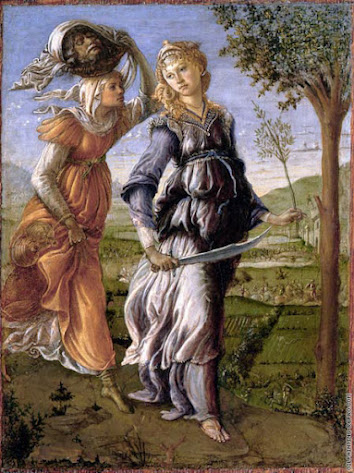Baroque Blog Post: Saint Jerome Writing
The Baroque period was marked by a distinct departure from the traditional values and ideals of the Renaissance. Art was more emotional and captured moments in time, as opposed to Renaissance art, which prioritized stability and timelessness. Baroque artists were less interested in perfection, and more interested in showing real glimpses of human life, without the idealized beauty of the Renaissance. ("Renaissance Philosophy")
The church played a major part in this shift. The Council of Trent (1545-1563) was a gathering held by the Catholic Church as a response to the growing threat of Protestantism. The importance and impact of the Council cannot be understated. It has been described as the embodiment of the Counter-Reformation. A myriad of topics were discussed at the council in an attempt to purge Protestantism from the land, including the arts. Realizing they needed to make Catholicism more accessible to the common person, church leaders began encouraging religious art that was simple, easy to understand, and conveyed a message of devotion to God and the church. Art during the Renaissance was layered with complexities and symbols meant to be understood only by the educated, but Baroque artists made appreciating art easy for everyone. ("Council Of Trent | Definition, Summary, Significance, Results, & Facts")
One of my favorite examples of Baroque style is Saint Jerome Writing by Caravaggio. Caravaggio’s style was strongly marked by tenebrism, or extremely pronounced use of light and dark. The use of deep darkness and contrasting highlights makes his works bold, standing out and capturing the attention. However, his works also show beautiful delicacy and detail, proving Caravaggio’s skill as a master. Saint Jerome Writing showcases both style and skill perfectly in a simple, yet beautiful depiction of the saint at work.
Painted in 1605, right at the beginning of the Baroque period, this work is oil on canvas, 44 x 62 inches. It depicts the elderly Saint Jerome sitting at a table, hunched over a book and writing with one hand. You can barely see the glimmer of a halo hovering over his head to show that he is a saint. He is wrapped in a billowy red cloth, which extends onto the book-covered table. A skull rests atop an open book as a stark reminder of mortality. Saint Jerome’s frail figure is surrounded by solid rectangular forms. The shape of the table and the huge books all contrast sharply with his elderly form and the flowing sheet that surrounds him. (Writing, and Rome)
This painting simultaneously pulls the viewer in and shocks them. The dramatic lighting creates an intense mood, illuminating a single moment in the life of the saint. The background is deep and dark, leaving the viewer without having an idea of the setting. Is he in a cave? A dark library? A jail cell? We have no idea.
Here, it is clear to see the departure from the Renaissance. Jerome is not an idealized young man, he is old and nearing the end of his life. His body is weak and frail. In fact, Caravaggio seems to deliberately play on the idea of the impermanence of life. The human skull resting on the table is a blatant reminder that death comes to us all, saints or not. Even those who live a life devoted to God must die. Rather than glorifying humanity as the pinnacle of creation, Caravaggio reminds us that life is fleeting, and perhaps there is beauty in that after all. ("Baroque Art – The Key Artists And Paintings Of The Baroque Period")
By contrast, have a look at The Creation of Adam, by the famous Renaissance painter Michelangelo. This is one of the most famous Renaissance paintings ever, and it perfectly captures the style and sentiment of that time.
Michelangelo is clearly making a deliberate effort to portray humanity as beautiful, perfect, and glorious. This timeless scene is a clear representation of everything the Renaissance stood for. Adam is young and strong. His body shows no signs of imperfections or aging. Even God the creator, despite his gray hair, looks like he visits the gym on a very regular basis.
The Renaissance was a time of boundless optimism and confidence in humanity. It focused on the truth that humanity is beautiful, but unfortunately to the point of being unrealistic and somewhat cold. Baroque artists chose to accept the imperfections and quirks of their subjects and portray that beauty that comes with day to day life. People do not have to be perfect to be lovely, and life is still beautiful even though it must come to an end. ("Baroque Art – The Key Artists And Paintings Of The Baroque Period")
Bibliography:
Copenhaver, Brian P. "Renaissance philosophy." (1992).
"Council Of Trent | Definition, Summary, Significance, Results, & Facts". Encyclopedia Britannica, 2021, https://www.britannica.com/event/Council-of-Trent.
"Baroque Art – The Key Artists And Paintings Of The Baroque Period". Artincontext.Org, 2021, https://artincontext.org/baroque-art/.
Writing, Saint, and Borghese Rome. "Saint Jerome Writing By Caravaggio". Galerie Borghèse, 2021, https://borghese.gallery/collection/paintings/saint-jerome-writing.html.




Yeah, there's definitely some strong contrast of lighting going on in this one. I like how this one shows an imperfect human being, as we all are. The man in the painting, along with the rest of us, is just doing his best based on what he has. It's great that the people of this time period threw out the idea of the "idealized society" in a way and started being more realistic with their expectations.
ReplyDelete